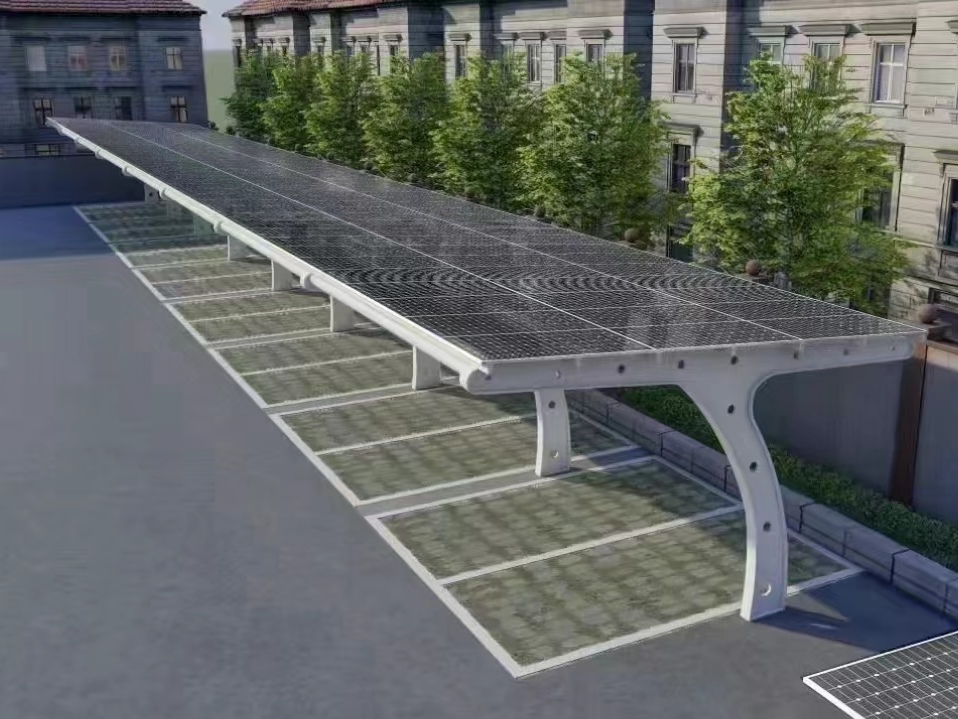The concept of solar carport structures merges the ingenuity of renewable energy solutions with the practicality of vehicle parking spaces. Serving as a testament to sustainable development, these carport structures not only provide shade and protection for vehicles but also harness solar energy, transforming mundane parking areas into power generation sites. This dual functionality exemplifies a significant leap towards eco-friendly infrastructure development. Meanwhile it marks a pivotal moment in the utilization of solar technology.
The evolution of solar carport structures is a narrative of technological innovation and growing environmental consciousness. Initially perceived as niche or supplementary energy solutions, these structures have garnered widespread popularity, thanks in part to their ability to offer a renewable energy source while minimizing land use. As urban spaces become more congested and the urgency to adopt sustainable practices intensifies, solar carports have emerged as a logical and efficient solution to meet these challenges.
Índice
Benefits of Solar Carport Structures
Solar carport structures stand as ideals of environmental stewardship. And it offers a plethora of benefits that extend well beyond their immediate utility. The ecological advantages are manifold. These structures mainly cut down the carbon output of residential and commercial properties by leveraging solar power, a clean and inexhaustible source of energy. This transition to solar energy sources is crucial for the global effort to combat climate change. And it contributes to solar carports a valuable asset in ecological preservation endeavors.
From a financial perspective, property owners stand to gain substantially from the installation of solar carport structures. These installations can dramatically decrease utility bills through the generation of onsite electricity, thereby providing a hedge against rising energy costs. Furthermore, the addition of a solar carport often increases property values, offering an attractive feature to potential buyers or tenants who prioritize sustainability. Coupled with government incentives and the possibility of selling excess electricity back to the grid, the financial benefits of solar carports are both immediate and enduring.
Design and Aesthetics
The integration of solar carport structures into the architectural landscape has evolved, with modern design trends emphasizing both functionality and aesthetic appeal. Designers and architects now view these structures as an opportunity to make a statement about innovation and sustainability, incorporating sleek lines, durable materials, and visually appealing configurations that complement the surrounding environment. This approach has transformed solar carports from purely utilitarian structures into significant architectural features that enhance the visual landscape.
Customization options further enhance the appeal of solar carport structures, allowing property owners to tailor designs to their specific needs and preferences. Whether it’s adjusting the size, shape, or color or integrating LED lighting and electric vehicle (EV) charging stations, the flexibility in design ensures that each solar carport can be as unique as the property it adorns. This level of customization not only satisfies individual aesthetic preferences but also addresses the functional requirements of different settings, making solar carports a versatile solution for a wide range of applications.
Especificações técnicas
The construction of solar carport structures involves a meticulous selection of materials and technology to ensure efficiency, durability, and aesthetic integration. The materials used in construction, typically including steel, aluminum, and sometimes wood, are chosen for their strength, longevity, and environmental sustainability. These materials must support the weight of solar panels and withstand weather conditions, emphasizing the importance of quality in construction practices.
Solar panel technology is another critical component of solar carport structures, with advancements in photovoltaic (PV) cells increasing the efficiency and energy output of these installations. Modern solar panels are capable of converting a higher percentage of sunlight into electricity, enhancing the overall productivity of the solar carport. Innovations in PV technology continue to push the boundaries of efficiency, making solar carports an increasingly influential source of renewable energy.
Processo de instalação
The installation of a solar carport structure is a complicated progress that requires complete, careful planning and consideration of various factors. Pre-installation considerations include:
- Assessing the site for solar potential.
- Obtaining necessary permits.
- Make sure the solar carport design complies with local building codes and regulations.
This phase is crucial for identifying any potential challenges that may arise during installation. At the same time it ensures that the project aligns with legal and environmental standards.
The steps of installation typically involve:
- Site preparation.
- The construction of the carport frame.
- The installation of solar panels.
- The integration of electrical systems.
Each step must be executed with precision and care to ensure the structural integrity of the carport and the efficiency of the solar panels. Professional installation teams are often involved in this process, bringing expertise and experience to navigate the technical and logistical complexities of constructing a solar carport.
Cost Analysis
Understanding the financial implications of installing a solar carport structure is essential for property owners considering this investment. The initial investment includes the cost of materials, installation, and any necessary permits or inspections. While the confront costs can be significant. The long-term financial benefits, including reduced energy bills and potential increases in property value, often justify the investment.
The return on investment (ROI) and savings associated with solar carports are compelling. Not only do these structures reduce or eliminate electricity costs by generating renewable energy, but they also qualify for various incentives, such as tax credits and rebates, which can significantly offset the initial costs. Over time, the savings accrued from a solar carport can surpass the initial investment, making it a financially sound decision for many property owners.
Maintenance and Durability
Routine maintenance is critical to ensuring the longevity and efficiency of solar carport structures. Maintenance tips include regular cleaning of solar panels to remove dust, debris, and snow, which can impede solar efficiency. Additionally, periodic inspections of the structural components and electrical systems can identify and address any potential issues before they become significant problems. This proactive approach to maintenance ensures that the solar carport continues to operate at optimal efficiency over its lifespan.
The durability of solar carport structures is influenced by the quality of materials and construction techniques used. High-quality materials and professional installation contribute to the longevity of these structures, with many designed to withstand harsh weather conditions and last for decades. This durability is a testament to the viability of solar carports as a long-term investment in renewable energy and sustainable infrastructure.
Regulatory and Compliance Issues
Navigating the regulatory landscape is a critical aspect of installing solar carport structures. Building codes and standards vary by location and are designed to ensure the safety and reliability of construction projects. Compliance with these regulations is mandatory and requires thorough understanding and planning to ensure that solar carport projects meet all legal requirements.
Incentives and government policies play a significant role in promoting the adoption of solar carport structures. Many jurisdictions offer tax credits, rebates, and other incentives to encourage property owners to invest in solar energy. These incentives not only make solar carports more affordable but also reflect the growing governmental support for renewable energy initiatives. Staying informed about these policies is crucial for maximizing the benefits and ensuring the success of solar carport installations.
Case Studies and Success Stories
Examining residential applications of solar carport structures reveals their potential to transform private properties into eco-friendly, energy-producing spaces. Homeowners across the globe have embraced solar carports, citing benefits such as reduced energy bills, increased property values, and the satisfaction of contributing to environmental sustainability. These success stories serve as powerful testimonials to the practical and financial advantages of solar carports in residential settings.
Commercial and industrial applications of solar carports demonstrate their scalability and versatility. Businesses, from small enterprises to large corporations, have integrated solar carports into their operations, taking advantage of the substantial energy savings and demonstrating a commitment to sustainability. These case studies highlight the adaptability of solar carports to different scales and types of applications, underscoring their role in the broader transition to renewable energy.
Future Trends in Solar Carport Structures
The horizon is bright for solar carport structures, with innovations in materials, design, and technology paving the way for even more efficient and versatile installations. Emerging trends include the integration of transparent solar panels, which allow for natural light to pass through while generating electricity, and the incorporation of intelligent technology for enhanced performance monitoring and energy management. These advancements promise to elevate the functionality and appeal of solar carports, ensuring their place in the future of sustainable infrastructure.
The role of intelligent technology in solar carport structures is becoming increasingly significant, offering new ways to optimize energy production and utilization. Features such as real-time energy monitoring, automated shading systems, and integrated EV charging stations exemplify the potential of technology to enhance the efficiency and user experience of solar carports. As these technologies continue to evolve, solar carports will likely play a pivotal role in the smart cities of the future, contributing to a more sustainable and energy-efficient urban landscape.
In conclusion, solar carport structures represent a confluence of innovation, sustainability, and practicality, offering a promising solution to the challenges of modern energy consumption and environmental preservation. As technology advances and awareness of renewable energy grows, solar carports are set to become a ubiquitous feature of the built environment, harnessing the power of the sun to provide clean, renewable energy for generations to come.
















